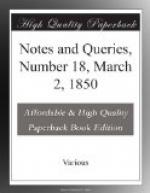GULES
Caesar’s Wife..—“NASO” wishes to know where the proverbial saying, “Caesar’s wife must not even be suspected,” first occurs.
Minar’s Books of Antiquities.—Can any one conversant with the works of Cardinal Nicolas de Cusa inform me what author he quotes as “Minar in his Books of Antiquities,” in what language, and where existing? De Docta Ignorantia, I. i. cap. 7.
A.N.
Proverb against Physicians.—“M.D.” wishes to be informed of the earliest writer who mentions the proverb “Ubi tres Medici, duo Athei.”
Compendyous Olde Treatyse.—In Ames’s Typographical Antiquities, vol. i. p. 405. (ed. Herbert), is described a work, printed by Rycharde Banckes, some time between 1525 and 1545, entitled, “A compendyous olde treatyse shewynge howe that we ought to have the Scripture in Englyshe, with the Auctours.” 12mo. 18 leaves. This copy belonged to Herbert himself, and was probably obtained at the sale of Thomas Granger, in 1732. Any information as to its wherabout at present, or the existence of any other copy of the above tract, would confer a fabour on the inquirer.
F.M.
The Topography of Foreign Printing Presses.—I have often been at a loss to discover the locality of names which designate the places where books have been printed at Foreign presses; and “when found” to “make a note of it.” I was therefore pleased to find in No. 16. p. 251., by the reply of “R.G.” to Mr. Jebb, that “Cosmopolis was certainly Amsterdam,” and that “Coloniae” signifies “Amstelaedami.” And I will take the liberty of suggesting that it would be an acceptable service rendered to young students, if your learned correspondents would occasionally communicate in the pages of your work, the modern names, &c. of such places as are not easily gathered from the books themselves.
P.H.F.
Cromwell’s Estates.—In Carlyle’s edition of Cromwell’s Letters and Speeches, there is a note (p. 75. vol. iv. of the 3rd ed. 1850) containing a list of the estates which the Protector owned at the time of his death, as follows; there being, besides Newhall, specified as “in Essex,” five, viz.—
“Dalby,
Broughton,
Burleigh,
Oakham, and
Egleton.”
of which the editor has ascertained the localities; and six, viz.—
L s. d “Gower, valued at 479 0 0 per an. Chepstall valued at 549 7 3 Magore valued at 448 0 0 Sydenham valued at 3121 9 6 Woolaston valued at 664 16 6 Chaulton valued at 500 0 0,”
of which, he say, “he knows nothing.”
It would surely be a proper, and, one might hope, an attainable object of inquiry, to search out these unplaced estates of the great Protector, and give them a local habitation in modern knowledge. This is precisely one of the kind of queries which your publication seems best fitted to aid; and I therefore submit it, in the hope of some discoveries, to your correspondents.




